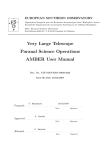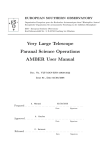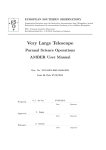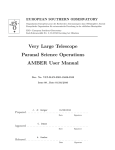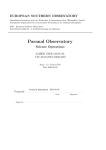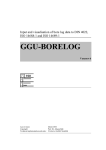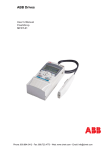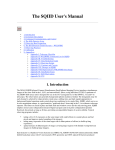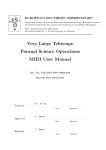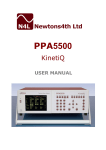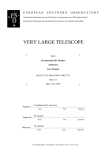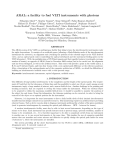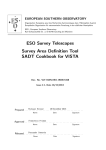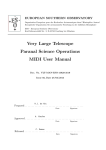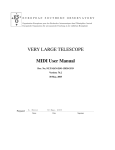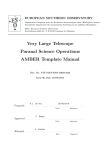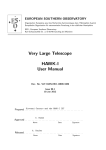Download AMBER User Manual
Transcript
EUROPEAN SOUTHERN OBSERVATORY Organisation Européene pour des Recherches Astronomiques dans l’Hémisphère Austral Europäische Organisation für astronomische Forschung in der südlichen Hemisphäre ESO - European Southern Observatory Karl-Schwarzschild Str. 2, D-85748 Garching bei München Very Large Telescope Paranal Science Operations AMBER User Manual Doc. No. VLT-MAN-ESO-15830-3522 Issue 79.1, Date 09/12/2006 Prepared F. Rantakyrö 09/12/2006 . . . . . . . . . . . . . . . . . . . . . . . . . . . . . . . . . . . . . . . . . . Date Approved A. Kaufer . . . . . . . . . . . . . . . . . . . . . . . . . . . . . . . . . . . . . . . . . . Date Released Signature Signature O. Hainaut . . . . . . . . . . . . . . . . . . . . . . . . . . . . . . . . . . . . . . . . . . Date Signature AMBER User Manual VLT-MAN-ESO-15830-3522 This page was intentionally left blank ii AMBER User Manual VLT-MAN-ESO-15830-3522 iii Change Record Issue/Rev. 79.1 79 Date Section/Parag. affected 2006-12-09 Instrument setup 2006-09-01 all Remarks IRIS guiding always used. Added info on ATs in various sections. AMBER User Manual VLT-MAN-ESO-15830-3522 This page was intentionally left blank iv AMBER User Manual VLT-MAN-ESO-15830-3522 v 1 INTRODUCTION 1.1 Scope of this manual . . . . . . . . . . . . . . . . . . . 1.2 What’s new in this issue of the AMBER User Manual? 1.3 Acknowledgments . . . . . . . . . . . . . . . . . . . . . 1.4 On the contents of the AMBER User Manual . . . . . 1.5 Contact Information . . . . . . . . . . . . . . . . . . . . . . . . 1 1 1 1 1 2 . . . . . . . 2 2 3 3 4 4 4 4 3 AMBER within the VLT interferometer 3.1 VLTI infrastructure . . . . . . . . . . . . . . . . . . . . . . . . . . . . . . . . . 3.2 Other VLT instruments . . . . . . . . . . . . . . . . . . . . . . . . . . . . . . . 6 6 6 Contents 2 Capabilities of the instrument 2.1 What measures AMBER? . . . . . . . . . . . . 2.2 Science accessible with the different observables 2.2.1 Absolute visibility V (f, λ) . . . . . . . . 2.2.2 Relative visibility V (f, λ)/V (f, λ0 ) . . . 2.2.3 Relative phase variation with wavelength 2.2.4 Closure phase and phase reconstruction . 2.3 AMBER characteristics . . . . . . . . . . . . . . 4 AMBER overview 4.1 AMBER principle . . . . . 4.2 AMBER layout . . . . . . 4.2.1 Warm optics . . . . 4.2.2 Spectrograph . . . 4.2.3 Detector . . . . . . 4.2.4 Calibration unit . . 4.3 From images to visibilities 4.4 Instrument performances . 4.5 Instrumental contrast . . . . . . . . . . . . . . . . . . . . . . . . . . . . . . . . . . . . . . . . . . . . . . . . . . . . . . . . . . . . . . . . . . . . . . . . . . . . . . . . . . . . . . . . . . . . . . . . . . . . . . . . . . . . . . . . . . . . . . . . . . . . . . . . . . . . . . . . . . . . . . . . . . . . . . . . . . . . . . . . . . . . . . . . . . . . . . . . . . . . . . . . . . . . . . . . . . . . . . . . . . . . . . . . . . . . . . . . . . . . . . . . . . . . . . . . . . . . . . . . . . . . . . . . . . . . . . . . . . . . . . . . . . . . . . . . . . . . . . . . . . . . . . . . . . . . . . . . . . . . . . . . . . . . . . . . . . . . . . . . . . . . . . . . . . . . . . . . . . . . . . . . . . . . . . . . . . . . . . . . . . . . . . . . . . . . . . . . . . . . . . . . . . . . . . . . . . . . . . . . . . . . . . . . . . . . . . . . . . . . . . . . . . . . . . . . . . . . 7 7 8 8 8 8 8 8 10 10 5 Instrument features and problems to be aware of 10 6 AMBER in P79 6.1 Service and Visitor Modes . . . . . . . . . . . . . . . . . . . . . . . . . . . . . 11 11 7 Preparing the observations 7.1 Choice of the VLTI configuration . 7.1.1 Telescopes . . . . . . . . . . 7.1.2 Baselines . . . . . . . . . . . 7.1.3 Coudéguiding with the UTs 11 12 12 12 12 . . . . . . . . . . . . . . . . . . . . . . . . . . . . . . . . . . . . . . . . . . . . . . . . . . . . . . . . . . . . . . . . . . . . . . . . . . . . . . . . . . . . . . . . . . . . . . . . AMBER User Manual VLT-MAN-ESO-15830-3522 . . . . . . . . . . . . . 13 13 13 14 14 14 14 15 15 15 15 15 15 8 Introducing Observation Blocks (OBs) 8.1 Standard observation (OBS Std) . . . . . . . . . . . . . . . . . . . . . . . . . . 8.1.1 Observing cycle . . . . . . . . . . . . . . . . . . . . . . . . . . . . . . . 8.2 Computing time overheads for added bands . . . . . . . . . . . . . . . . . . . 16 16 16 17 9 Bibliography 17 10 Glossary 17 11 Acronyms and Abreviations 19 7.2 7.1.4 Coudé guiding with the ATs . . . . . 7.1.5 Geometry . . . . . . . . . . . . . . . 7.1.6 Guaranteed time observation objects 7.1.7 Calibrator Stars . . . . . . . . . . . . 7.1.8 Field of View . . . . . . . . . . . . . 7.1.9 Complex fields . . . . . . . . . . . . 7.1.10 Bright objects . . . . . . . . . . . . . Choice of AMBER configuration . . . . . . . 7.2.1 Instrument set-up . . . . . . . . . . . 7.2.2 Observing modes . . . . . . . . . . . 7.2.3 Calibration cycle . . . . . . . . . . . 7.2.4 Calibrating the background emission 7.2.5 Standard calibration the instrumental . . . . . . . . . . . . . . . . . . . . . . . . . . . . . . . . . . . . . . . . . . . . . . . . . . . . . . . . . . . . . . . . . . . . . . . . . . . . . . . . . . . . . . . . . . . . . . . . . . . . . . . . . . . . visibility (Std) vi . . . . . . . . . . . . . . . . . . . . . . . . . . . . . . . . . . . . . . . . . . . . . . . . . . . . . . . . . . . . . . . . . . . . . . . . . . . . . . . . . . . . . . . . . . . . . . . . . . . . . . . . . . . . . . . . . . . . . AMBER User Manual 1 VLT-MAN-ESO-15830-3522 1 INTRODUCTION AMBER, the near-infrared focal instrument of the VLTI, operates in the bands J, H, and, K ie 1.0 to 2.5µm). The instrument has been designed to be used with two or three beams, thus enabling also the use of closure phase techniques. The magnitude limit of AMBER is K=7 with Low Resolution (LR-HK) on UTs and K=5 on the ATs, K=4 with Medium Resolution K-band (MR-K) on the UTs and K=1.6 on the ATs, and K=1.5 with High Resolution K-band (HR-K) on UTs 1.1 Scope of this manual This document summarizes the features and possibilities of the Astronomical Multi-BEam combineR (AMBER) of the VLT, as it will be offered to astronomers for the six-month ESO observation period number 79 (P79), running from April 1st 2007 to September 30 2007. Only the features that are supported by ESO for P79 are given in this document. The bold font is used in the paragraphs of this document to put emphasis on the important facts regarding AMBER in P79 and should be considered by the reader. 1.2 What’s new in this issue of the AMBER User Manual? AMBER is now always using IRIS for guiding, and IRIS is taking 25% of the K band flux. The user should give the H and K band magnitudes of the target. AMBER limiting magnitudes for the Auxilliary Telescopes (ATs). 1.3 Acknowledgments The editor thanks Fabien Malbet (LAOG, Grenoble) who delivered the document which formed the first first version of this manual in February 2005. The editor also thanks Markus Wittkowski at ESO-Garching for his comments and Stephane Brillant and Stan Stefl in Paranal for their comments. 1.4 On the contents of the AMBER User Manual Section 2 of this manual is aimed at users who are not familiar with the AMBER instrument and who are interested in an overview of its capabilities. Section 3 describes the AMBER instrument within the VLTI framework, and section 4 provides the description of the instrument: the instrument layout (sec. 4.2), the expected performances (sec. 4.4) and a reference to instrument features to be kept in mind while planning the observations or reducing the data (sec. 5). It can be consulted by users who want to prepare an Observing Proposal (Phase I), but should definitively be read by those who have been granted observing time and have to prepare their observations (Phase II). In Section 6 I present some added information pertinent to observing with AMBER in P79. Section 7 provides the basic information needed to prepare a program: the configuration of the VLTI (sec. 7.1), the identification of the observing modes and of the standard settings (sec. 7.2). AMBER User Manual 1.5 VLT-MAN-ESO-15830-3522 2 Contact Information The aim of this manual is to make the users get acquainted with the AMBER instrument before writing proposals. In particular sections 3, 1, 2, 4, and 4.3 are aimed at astronomers not used to interferometric observations. This document is evolving continually and needs to be updated and improved according to needs of the astronomers. All questions and suggestions should be channeled through the ESO User Support Department (email:[email protected] and homepage: http://www.eso.org/org/dmd/usg/). The AMBER Home Page web page is found at the following URL: http://www.eso.org/instruments/amber/. Any user of the instrument should visit the web page on a regular basis to be kept informed about the current instrument status and developments. 2 Capabilities of the instrument What follows is not intended to be perfectly accurate from a mathematical point of view but to remind what is accessible in practice. In principle the contrast and phase of the fringes observed on a source with given baseline B and wavelength λ yield the amplitude and phase of the Fourier transform of the source brightness distribution at the spatial frequencies f = B/λ. If this Fourier function is sufficiently sampled in the Fourier plane, then an inverse Fourier transform yields a model independent reconstruction of the image of the object at the wavelength λ with an angular resolution λ/Bmax . Besides the sensitivity limits, two classes of problems make this imaging process quite difficult. – First calibrating the measurements, i.e. deducing the object visibility and phase from the fringes contrast and position. Second, making measurements at a sufficiently sampled Fourier plane can be timeconsuming. This is why, although making images will actually be the goal of AMBER on the VLTI in some cases, it is worth examining what kind of astrophysical information can be extracted from any individual AMBER measurement for a given baseline configuration. 2.1 What measures AMBER? AMBER is a beam combiner for up to three beams feeding a spectrograph and a camera working in the near infrared from 1 to 2.5 microns. It is a single mode instrument, which means that each baseline give access to only one point in the frequency space per spectral channel. For this baseline, the instrument is designed to measure: – the absolute visibility in each spectral channel. – the relative visibility, i.e. the ratio between the visibility in each spectral channel and the visibility in a reference spectral channel (average of several other channels for example). – the phase difference, i.e. the difference between the phase in each spectral channel and the phase in a reference channel. This is the main purpose of Differential Phase observations. AMBER User Manual VLT-MAN-ESO-15830-3522 3 – the closure phase when used with three beams. for the following spectral resolutions: 35, 1500 and 12000 and a spectral coverage containing the K, H and J bands. The scope of this manual is limited to the measure and calibration of single (or triplets) (u, v) points and do not address the use these measurements to constrain astrophysical models or the image reconstruction process. 2.2 Science accessible with the different observables Thanks to the combination of instrument performance, choice of baselines, closure phase capability, and the photon-collecting power of the VLTI, a wide range of astronomical sources can be targeted. What follows is a brief presentation of the major objectives, which are in no way a full listing of all scientific possibilities of the instrument. Most of these objectives need the PRIMA (astrometry, fringe stabilizer, and dual feed) facility or FINITO (fringe tracker) to realise the objectives to their full extent, but even without these, AMBER will be able to make great advances in several areas including the following areas: • Hot extrasolar planets: Determination of planetary mass, orbital parameters and the spectra of the planet and the star. • Active Galactic Nuclei: Spatially resolve the Broad Line Region and to constrain its geometry and kinematics. The ionized disks around the putative Massive Black Hole can be studied to constrain its morphology, size, and, velocity and density field. Measuring the wavelength dependence of the central point source, the shape and size of circumnuclear dust structures as well as additional structures (e.g., the inner region of jets, circumnuclear starburst regions, or bars) in order to test AGN models. • Circumstellar material in hot/cold and young/old stars: Constraints on the size and morphology of the disk, including velocity and density fields. Similarly, jets and bipolar outflows can be studied, obtaining sizes, morphology, and, velocity and density fields. • Binaries: Direct measurement of actual orbital motions, and the masses of the stars. • Stellar structure: Measurements of the radius, ellipticity, surface activity, and, limbdarkening effects. 2.2.1 Absolute visibility V (f, λ) If the source is bright or if a bright reference star is close enough, it is possible to obtain an unbiased estimate of the source visibility amplitude from the fringe contrast. A visibility measure for a single baseline can constrain the equivalent size of the source for an assumed morphology. Visibility measures for several spatial frequencies (obtained through Earth rotation, different wavelength, different baseline) constrain severely the models. However the interpretation of the results remains always model dependent. Different images can lead to similar visibilities and discriminating between models usually requires measures with high accuracy. In general, the phase of the fringes cannot be related to the phase of the source Fourier transform because of the atmospheric phase jitter. Only relative phase measurements are possible for sufficiently close spectral bands. This can be extended to spectral bands further AMBER User Manual VLT-MAN-ESO-15830-3522 4 away using a correct model of the atmosperic effects, but this is out of the scope of the standard data reduction. 2.2.2 Relative visibility V (f, λ)/V (f, λ0 ) In some cases, one is interested in the variation of the target spatial intensity distribution with the wavelength. This is the case when observing a structure which is present in a spectral line, whereas the continuum corresponds to an unresolved structure. One can then calibrate the measurement in the line by those in the continuum and the knowledge of the absolute visibility is not required, just the ratio between the visibility at a given wavelength and a reference channel. 2.2.3 Relative phase variation with wavelength If the instrument is operated simultaneously at different wavelengths, then one can measure the variation of the phase with the wavelength. The principle is exactly the same as in astrometry, except that the reference is the source itself at a given wavelength. The most remarkable aspect of this phase variation is that it yields angular information on objects which can be much smaller than the interferometer resolution limit. This features comes from the possibility to measure accurately phase variations much smaller than 2π. When the object is non resolved, the phase variation Φ(f, λ) − Φ(f, λ0 ) yields the variation with wavelength of the object photocenter (λ) − (λ0 ). This photocenter variation is a powerful tool to constrain the morphology and the kinematics of objects where spectral features result from large scale (relatively to the scale of the source) spatial features. Note that if this is attempted over large wavelength ranges the atmospheric effects has to be corrected in the data reduction. 2.2.4 Closure phase and phase reconstruction If fringes are present at all three baselines and the fringes for all baselines are analyzed simultaneously, then we obtain a relation called closure phase. The closure phase relations are independent from any antenna-based atmospheric or instrumental phase offsets affecting the beams before arriving to the telescopes. If all spatial frequencies have their phases in partially redundant closure phase relations, an iterative algorithm allows to compute all phases step by step. Then it is therefore possible to reconstruct the image if the (u, v) plane is well filled or to constrain the models if only some closure phases are available. 2.3 AMBER characteristics The main capabilities of AMBER are summarized in Table 1. It should be noted that the Instrument Visibility Accuracy in the table only reflects the current status of the instrument and is expected to improve in the coming periods. AMBER User Manual VLT-MAN-ESO-15830-3522 Table 1: AMBER characteristics and observing capabilities Description Specification Number of beams Spectral coverage Spectral resolution in K Two or Three JHK0 (1 − 2.5 µm) R ∼35 R ∼1500 R ∼12000 same as in K 0.8 9% (3σ) 2% in K 1% in J and H 1024 × 1024 detector array 11.37− 0.8 V (f, λ), V (f, λ)/V (f, λ0 ), Φ(f, λ) − Φ(f, λ0 ), Φ123 (λ) Spectral resolution in J & H Instrument contrast Visibility accuracy Optical throughput Detector size Detector read-out noise Detector quantum efficiency Observables 5 AMBER User Manual 3 VLT-MAN-ESO-15830-3522 6 AMBER within the VLT interferometer 3.1 VLTI infrastructure AMBER is the final stage of an overall infrastructure. It is part of a VLTI well defined plan. The general concept of the VLTI is to provide an interferometric focus to the instruments, like modern telescopes provide almost diffraction-limited beams to their instruments. Therefore the VLTI infrastructure works like a general facility which supplies the following functions: - Sampling of the (u, v) plane with 4 fixed Unit Telescopes (UTs) and 3 movable Auxilliary Telescopes (ATs) with baselines ranging from 8m to 200m. - Collection of light with four 8 m Unit Telescopes (UTs) and three 1.8 m Auxilliary Telescopes (ATs). - Wavefront correction at the telescopes: in the first phase adaptive optics for the UTs (MACAO) and tip-tilt correction for the ATs (STRAP). - Transportation of the primary and secondary beams from the telescopes to the focal lab. - Compensation by the delay lines (DLs) of the optical path difference due to the sidereal motion. - Correction of the slow (<1 Hz) tip/tilt motion of the beams (caused by tunneling seeing effects) by means of a fast detector sensing the beam motions and sending corrections to the X-Y table so that the beams are kept centered on the optical axis (IRIS). IRIS uses 25% of the K-band for the guiding. 3.2 Other VLT instruments AMBER yields information at scales between λ/B and λ/D. A single mode instrument like AMBER has therefore no direct access to structures larger then λ/D. Like for radio interferometer, one might need in certain cases information at small spatial frequencies in order to inject it with the data collected with AMBER. The best-suited instrument that can give access to this data is the NAOS/CONICA and SINFONI instruments which measures diffractionlimited images in the the same wavelength domain as AMBER. With NAOS/CONICA it is possible to do both imaging and spectrography and SINFONI is unique in that it does full field spectrography in a 3” by 3” field. Further information on these instruments can be found at: http://www.eso.org/instruments/naco. and http://www.eso.org/instruments/sinfoni. The MIDI instrument is similar to AMBER but operates with two telescopes in the N-band. AMBER and MIDI instruments use the same interferometric infrastructure, and many aspects regarding observing preparation and scheduling are very similar. More information on MIDI can be found at the following web address: http://www.eso.org/instruments/midi. AMBER User Manual VLT-MAN-ESO-15830-3522 7 Figure 1: Basic concept of AMBER: (1) multi axial beam combiner. (2) cylindrical optics. (3) anamorphosed focal image with fringes. (4) ”long slit spectrograph”. (5) dispersed fringes on 2D detector. (6) spatial filter with single mode optical fibers. (7) photometric beams. 4 4.1 AMBER overview AMBER principle Figure 1 summarizes the key elements of the AMBER concept. AMBER has a multi axial beam combiner. A set of collimated and parallel beams are focused by a common optical element in a common Airy pattern which contains the fringes (-1- in Fig. 1). The output baselines are in a non redundant set up, i.e. the spacing between the beams is selected for the Fourier transform of the fringe pattern to show separated fringe peaks at all wavelengths. The Airy disk needs to be sampled by many pixels in the baseline direction (an average of 4 pixels in the narrowest fringe, i.e. at least 12 pixels in the baseline direction) while in the other direction only one pixel is sufficient. To minimize detector noise each spectral channel is concentrated in a single column of pixels (-3- in Fig. 1) by cylindrical optics (-2- in Fig. 1). The fringes are dispersed by a standard ”long slit” spectrograph (-4- in Fig. 1) on a two dimensional detector (-5- in Fig. 1). For work in the K band with resolutions up to 12 000 the spectrograph must be cooled down to about -60◦ C with a cold slit in the image plane and a cold pupil stop. In practice we found it simpler to cool it down to liquid nitrogen temperature. To produce high accuracy measurements, it is necessary to spatially filter the incoming beams to force each one of them to contain only a single coherent mode. To be efficient, the spatial filter must transmit at least 103 more light in the guided mode than in all the secondary modes. For the kind of imperfect AO correction (Strehl ratios often <50%) available for the VLTI, the single way to achieve such high filtering quality with decent light transmission is to use single mode optical fibers (-6-in Fig. 1). The flux transmitted by each filter must be monitored in real time in each spectral channel. This explains why a fraction of each beam is extracted before the beam combiner and sent directly to the detector through a dispersive element (-7- in Fig. 1). The instrument must also perform some beam ”cleaning” before entering the spatial filter, such as correcting for the differential atmospheric refraction in the H and J bands or, in some cases, eliminating one polarization. AMBER User Manual 4.2 VLT-MAN-ESO-15830-3522 8 AMBER layout Figure 2 shows the global implementation of AMBER with the additional features needed by the actual operation of the instrument. 4.2.1 Warm optics There are three spatial filters, one for each spectral band, because of the limited wavelength range over which a fiber can remain single mode. The three spatial filters inputs are separated by dichroic plates. For example the K band spatial filter (OPM-SFK) is fed by dichroic which reflect wavelengths higher than 2 µm and transmit the H and J bands. After the fiber outputs, a symmetric cascade of dichroics combines the different bands again, but the output pupil in each band has a shape proportional to the central wavelength of the band. Therefore the Airy disk and the fringes have the same size for all central wavelength. This allows to use the same spectrograph achromatic optics for all bands and to have the same sampling of all the central wavelengths. Then the beams enter the cylindrical optics anamorphoser ”OPM-ANS” before entering the spectrograph SPG through a periscope used to align the beam produced by the warm optics and the spectrograph. 4.2.2 Spectrograph The spectrograph has an image plane cold stop, a wheel with cold pupil masks for 2 or 3 telescopes. The separation between the interferometric and photometric beams is performed in a pupil plane inside the spectrograph, after the image plane cold stop. 4.2.3 Detector After dispersion, the spectrograph chamber sends the dispersed image on the detector chip DET. 4.2.4 Calibration unit The Calibration and Alignment Unit (OPM-CAU), contains all calibration lamps and can emulate the VLTI in the integration, test and calibration phases. The matrix calibration system (OPM-MCS) is set of plane parallel plates which can be introduced in the beam sent by the OPM-CAU in order to introduce the λ/4 delays in one beam necessary to calibrate the matrix of the ”pixel to visibility” linear relation. Several components of the AMBER instrument, such as the dichroics, the fibers, the filters, the beam splitter, the cryostat window are optimized for only one polarization. Then, the other polarization will provide only a small gain in flux but can produce a substantial loss in contrast. To avoid this, one polarization is eliminated by polarization filters (OPM-POL) located on the AMBER table before the dichroics. 4.3 From images to visibilities The raw data produced by AMBER are images of the overlap of the 3 beams dispersed by a prism (LR) or grisms (MR and HR). Because of the beam splitter, one get in addition 3 AMBER User Manual VLT-MAN-ESO-15830-3522 Figure 2: Amber global implementation Figure 3: Photography of AMBER at Paranal 9 AMBER User Manual VLT-MAN-ESO-15830-3522 10 photometric outputs corresponding to each beam. An image of the detector image is displayed on Fig. 4. The fringes are processed for each wavelength individually. In fact 3 fringe system are present in the interferometric output, and, the first action consists in separating them apart. During the calibration, the carrying wave corresponding to each baseline are recorded and the interference term of the base ij is for the pixel k: q mij (k) = 2 Pi Pj (cij (k)Vij cos(Φij (k)) + dij (k)Vij sin(Φij (k))) (1) The quantities cij (k) and dij (k) are called the carrying waves and are displayed on Fig. 5. These waves are in quadrature so that each pixel is sensitive to a complex number. Therefore we can write the photometry subtracted interferogram icorr (k) as: X mij (k) (2) = M (k) × C (3) icorr (k) = j>i where C is a vector of the values (Rqij , Iij ) corresponding respectively to the real- and imaginary-part of the correlated flux 2 Pi Pj Vij for all baselines and M (k) is a matrix with the values of the carrying wavescij (k) and dij (k). The matrix M (k) is the so-called pixel-tovisibilities matrix (P2VM). During calibration, one can measure the P2VM and then inverse it so that for each pixel we get the visibility. 4.4 Instrument performances 4.5 Instrumental contrast The inherent instrumental contrast of AMBER is measured during the P2VM calibration procedure that occurs every time that we change the spectral set-up of the instrument after the fibers. The P2VM observation is automatically included in the standard templates and thus requires no input or configuration by the observer. Please read sction 4.3 for an extensive explanation of the use of the P2VM during data reduction. 5 Instrument features and problems to be aware of The AMBER instrument is not yet fully commissioned. The following caveats should be taken into consideration: • Vibrations have been found in the VLTI arm which have been partially fixed. Residual vibrations may still exist. • OPD model may not be completely optimized and time can be lost to find fringes in particular in the LR mode. • Due the the absence of a fringe tracking system (FINITO), the spectral coverage can be severely limited to a dozen of pixels. • Differential visibilities and phases (see sections 2.1 and 2.2.3) can be used. but differential modes using the Beam Commuting Device (BCD) are not yet available. AMBER User Manual VLT-MAN-ESO-15830-3522 11 • AMBER is a single-mode instrument and therefore the field of view is limited to the Airy disk of each individual aperture, i.e. 250 mas for the ATs in K and 60 mas for the UTs in K. 6 AMBER in P79 AMBER combines most of the aspects that usually exist independently in several astronomical instruments. It involves visibility measurements (interferometry), spectral dispersion (spectroscopy), and background level corrections. Hence, AMBER in its final configuration will feature a large number of modes selectable by the user. However, most of the modes are still under development. In P79 the only modes offered will be the High Resolution K band (HR-K), Medium Resolution K band (MR-K) and the low resolution K band (LR-JHK), with a spectral resolution λ/∆λ of approximately 12000, 1500 and 35, respectively. In LR-JHK mode, the K band will be acquired simultaneously with the H band. IRIS which is always used is taking 25% of the K-band flux and H-band is sent undimished to AMBER. See the AMBER instrument webpage: http://www.eso.org/instruments/amber/inst/ for the most recent information on the exact wavelength ranges and section 7.2.1 for the configuration options for the spectrograph. 6.1 Service and Visitor Modes For P79, AMBER is offered in service mode and in visitor mode (see Sect. 10). During all the period, the unique contact point at ESO for the user will be the User Support Department (email:[email protected] and homepage: http://www.eso.org/org/dmd/usg/). The visitor mode is more likely to be offered for proposals requiring non-standard observation procedures. The OPC will decide whether a proposal should be observed in SM or VM. As for any other instrument, ESO reserves the right to transfer visitor programs to service and vice-versa. 7 Preparing the observations Submission of proposals for AMBER should be done through the ESOFORM. It is important to carefully read the following information before submitting a proposal, as well as the ESOFORM user manual. The ESOFORM package can be downloaded from: http://www.eso.org/observing/proposals/ Considering a target which has a scientific interest and for which AMBER could reveal interesting features, the first thing to do is to determine whether this target can be observed with AMBER or not. At this point, AMBER is offered with conservative performance estimates. The details of the current magnitude limits can be found at the AMBER instrument webpage: http://www.eso.org/instruments/amber/inst/ AMBER User Manual 7.1 7.1.1 VLT-MAN-ESO-15830-3522 12 Choice of the VLTI configuration Telescopes The available telescopes for AMBER are the 8 m Unit Telescopes (UTs) and the 1.8 m Auxulliary Telescopes (ATs). For detailed information on the UTs, ATs, and their active optics subsystems please see Sections 7.1.3 and 7.1.4. What is important in the choice of telescopes is the needed light collecting area and the baseline between the telescopes, and not the maximal baseline across the mirror. 7.1.2 Baselines For a list of the offered telescope configurations, please refer to the to the VLTI baseline page at http://www.eso.org/paranal/insnews/vlti/. This page contains detailed information about the baseline lengths, angles and available telescope triplets using the UTs or the ATs. 7.1.3 Coudéguiding with the UTs Each UT is equipped with an adaptive optics system called MACAO. It consists of a Roddier wavefront curvature analyzer using an array of 60 avalanche photodiodes. This analyzer applies a shape correction on the M8 deformable mirror of the UT. The M8 is mounted on a tip-tilt correction stage. In this case, the telescope is tracking in ”field stabilization” mode. In this mode, the Nasmyth guide probe camera tracks on a selected guide star (observable within the 30-arcmin Nasmyth FOV which is centered on the science target) by tip-tilting the M2. When at limit, the M2 is offloaded to the alt-az axes of the telescope. The tip-tilt mount of the M8 is offloaded by offsetting the Nasmyth guide probe position, and therefore by offsetting the M2 or the alt-az axes. The sensitivity of MACAO is V=16 for a 20% Strehl at 2.2µm (compared to the 50% strehl at V<12, at which the AMBER limiting magnitudes were estimated). In practice with AMBER, MACAO can be used with V=17 with the limitations that reduced strehl will yield. Note: There is also the additional constraint that the object should be fainter than V=1 for MACAO to work properly. The user should also be aware that Coudé guiding is not guaranteed to work for objects with 15<V<17 and the user should preferably select another guide star. If the target to observed is fainter than V=17, it is possible to perform ”off-target Coudé guiding”, provided a suitable guide star exists. This guide star must be brighter than V=17 and closer than 57.5 arcsec to the target to be observed with AMBER. It should be clear that the fainter the Coudé guide star the less optimal correction on the science object ie. objects close the limiting magnitudes of AMBER should use bright (Vmag ¡13) guide stars and not request seeing worse than 0.8”. A detailed description of the MACAO performance vs Coudé guide star magnitude can be found at URL: http://www.eso.org/instruments/sinfoni/inst/aosystem.html. There are also a few weather condition constraints for proper MACAO performance: • Seeing < 1.5 arcsec. • τ0 >1.5 ms. • Airmass <2 AMBER User Manual VLT-MAN-ESO-15830-3522 13 These constraints do not affect Service observations as OBs are only classified as A or B if MACAO has been performing within the tolerances. The constraints are given here for Visitor mode observations to give the user the conditions under which MACAO will perform as expected. Thus during non ideal weather conditions outside the MACAO performance ranges the user could ameliorate the effects to some degree by only using brights guide stars and only observe at high elevation. 7.1.4 Coudé guiding with the ATs Each AT is equipped with the tip-tilt corrector called STRAP. It consists of a avalanche photodiode quadrant which measures the tip-tilt of the incoming wavefront. The measured tip-tilt is compensated by acting on the M6 mobile mirror. When at the limit, M6 is offloaded to the alt-az axes of the telescope. The sensitivity of STRAP on the ATs is Vmag =13. If the target to observed is fainter than Vmag ∼13, it is possible to perform offtarget Coudé guiding, provided a suitable guide star exists. This guide star must be brighter than Vmag ∼13 and closer than 57.5 arcsec to the target to be observed with AMBER. If Vmag is fainter than 12, there is a risk that Coudé guiding cannot be performed, depending on the off-axis distance and on the sky conditions (seeing, τ0 ). It should also be noted that the expected correction with STRAP drops with distance between the science target and the Coudé guid star. Having a Coudé off-axis guide star at the formal maximum off-axis distance will not allow AMBER to reach the specified limiting magnitudes. Thus it is strongly recommended that the Coudé guide star is brighter than Vmag ∼12 and as close to the science target as possible. Note that, unlike the UTs, the ATs have no possibility of guiding if they cannot guide with the Coudé. Therefore, it is mandatory to use a suitable Coudé guide star (either the target itself or an off axis guide star). 7.1.5 Geometry Important parameters of the instrument to be taken into account for the preparation of the observing schedule are the VLTI geometry during observation ((u, v) coverage). The selection of the baseline requires the knowledge of both the geometry of the VLTI and of that of the target. To assess observability of a target with VLTI, it is suggested to use the VisCalc software, as this is the only ESO supported software. The front-end of VisCalc is a comprehensive web-based interface. VisCalc can be used from any browser from the URL: http://www.eso.org/observing/etc. Since we had problems in service mode in the past with over-resolved targets (which appeared resolved in imaging mode at the acquisition, or for which no fringes were found), we encourage the user to collect as much information on their target as possible, before submitting an AMBER proposal. 7.1.6 Guaranteed time observation objects It is important to check any scientific target against the list of guaranteed time observation (GTO) objects. This guaranteed time period covers the full P79. To make sure that a target has not been reserved already, the list of GTO objects can be downloaded from: http://www.eso.org/observing/proposals/gto/amber/index.html AMBER User Manual 7.1.7 VLT-MAN-ESO-15830-3522 14 Calibrator Stars High quality measurements require that the observer minimizes and calibrates the instrumental losses of visibility. To get a correct calibration, the user should use appropriate calibrator stars in terms of target proximity, calibrator magnitude and apparent diameter. In the case of AMBER, the calibrator is observed after the science target, using the same templates. For each science target, a calibrator star must be provided by the user with the submission of the Phase2 material. To help the user to select a calibrator, a tool called ”CalVin” is provided by ESO. CalVin can be used from any web browser. Like VisCalc, CalVin can be used on the web from: http://www.eso.org/observing/etc/ 7.1.8 Field of View AMBER is a single-mode instrument and therefore the field of view (FoV) is limited to the Airy disk of each individual aperture, i.e. 250 mas for the ATs in K and 60 mas for the UTs in K. For most observations this will not come into effect but can be limiting to observations of objects that consists of several components f.ex binaries, stars with disk and/or winds, etc. The observer should be aware that if the components are separated by more than the FoV only one of the components will be seen by AMBER. 7.1.9 Complex fields For normal observations of single objects there are no special constraints on the seeing, it is sufficient that MACAO or STRAP are working within the normal constraints (see Sections 7.1.3 and 7.1.4). When observing complex fields with several objects within a few arcseconds the situation is more complex. For fields with several objects within 1 to 3 arcseconds it is not guaranteed that MACAO will perform properly. It is therefore recommended to use a guide star in this situation. For fields with objects with separations less than an arcsecond MACAO will resolve the objects down to ∼0.1-0.15 arcsec. Due to the way that light is injected into AMBER (injection procedure only maximises the flux injected into the fiber) it cannot be guaranteed in the case of separations smaller than ∼0.2-0.3 arcsec that the proper target has been injected into the fiber. These kind of observations will have to follow a non standard extensive procedure to perform the injection adjustment and will require the presence of the PI (Visitor Mode). 7.1.10 Bright objects In Low Resultion observations (LR) of very bright objects (Kmag < 0), the detector can saturate even with using Neutral density filters during excellent weather conditions. The user should consult the webpages for the latest information on the magnitude limits. If possible the user should try to use the MR spectral configuration if the scientific goals still can be achieved in this mode. AMBER User Manual 7.2 7.2.1 VLT-MAN-ESO-15830-3522 15 Choice of AMBER configuration Instrument set-up The instrument set-up is defined by the spectral configuration of the instrument and the 3T configuration. In each 3T configuration the spectral configuration can be: – R = 35: 75% K band and 100% H band with IRIS guiding (Low JHK). – R = 1500: K in medium resolution (Medium K 1 2.1 and Medium K 1 2.3). – R = 12000: High resolution K-band observations. The details on the exact wavelength ranges, DITs, and central wavelengths available can be found on the AMBER Instrument webpage (http://www.eso.org/instruments/amber/index.html). Any change of the spectral configuration requires an internal calibration, i.e. spectral calibration and P2VM calibration. This is automatically taken care of by the internal calibration plan and no action or setups are needed from the user. Note that only one spectral configuration is allowed in one OB. Any change of the neutral densities, the polarizers, the BCD, the ADC, the position of the fiber heads, i.e. all elements located before the spatial filters does not require internal calibrations. They can be used or not depending on the source characteristics. 7.2.2 Observing modes The observing mode is characterized by the detector integration time (DIT). Currently only fixed DITs of 25, 50, or 100 ms (ATs only) are offered using the UTs and ATs. The user should consult with the AMBER Instrumentation webpages for further information on the available integration times. It should be noted that the choice of DIT affects the width of the central band in MR-K and HR-K observations. The user should check the AMBER Template Manual and the AMBER webpages for further information. 7.2.3 Calibration cycle 7.2.4 Calibrating the background emission It is necessary to measure the sky and the instrumental emission in order to subtract this background to the science images. The procedure consists in observing a source free region. This observation is performed with the same set-up as the science observation and close in time (about 5 minutes). 7.2.5 Standard calibration the instrumental visibility (Std) It is necessary to determine the instrumental complex visibility that affects (multiplicatively) the measured visibility. The procedure consists in observing a point-like source, or a target which intrinsic visibility is known (the reference object has to be close to the science object). This observation has to be performed with the same set-up as the science observation and close in time. AMBER User Manual 8 VLT-MAN-ESO-15830-3522 16 Introducing Observation Blocks (OBs) For general VLT instruments, an Observation Block (OB) is a logical unit specifying the telescope, instrument and detector parameters and actions needed to obtain a single observation. It is the smallest schedulable entity which means that the execution of an OB is normally not interrupted as soon as the target has been acquired. An OB is executed only once; when identical observation sequences are required (e.g. repeated observations using the same instrument setting, but different targets), a series of OBs must be constructed. An OB can contain only one target, but can contain several telescope offsets to measure the sky for example. In the case of interferometry instruments, the situation is a little bit different since we need calibrator stars to assess the atmosphere + instrument system visibility (cf. sec. 7.2.3). Thus each science object OB should be accompanied by a calibrator OB. These OBs should be identical in instrument setup, having only different target coordinates. Moreover with single-telescope instruments, any OB can be performed during the night. In the case of interferometric instrument, the instant of observation define the location of the observation in the (u, v) plan. 8.1 Standard observation (OBS Std) The same exposure cycle can be used for two or three telescopes. If only two telescopes are available (2 UTs), the third pupil is closed up in the spectrograph cold pupil plane, in order to reduce the background. The correction of instrumental biases is based on the use of a reference star and the sequence of operations is as presented in Fig. 6. 8.1.1 Observing cycle A standard observation with AMBER in P79 can be split in the several subtasks: 1. Configuration: Setup of the desired spectral resolution, wavelength range and DIT. 2. Internal calibration of the chosen instrument configuration (P2VM) see sec. 4.2.4. 3. Acquisition: Slew telescopes to target position on sky, and slew the delay-lines to the expected zero-OPD position and bring the DLs in ”tracking” state (pre-defined sidereal trajectory). (a) As stated in Secs 7.1.3 and 7.1.4, the user has the possibility to use a guide star for the Coude systems, different from the target. He/she will have to indicate the coordinates of this star, which, for the UTs should be brighter than V=17 and fainter than V=1 and within a 1-arcmin radius from the science target. 4. Injection Adjustment: Adjust telescope positions, so the beams from the target will center on the injection fibers in AMBER. 5. Fringe Search: Search the optical path length (OPL) offset of the tracking delay-lines yielding fringes on AMBER (actual zero-OPD), by OPD scans at different offsets. When fringes are found the atmospheric piston is calculated and the OPL offsets corresponding to zero-OPD are applied. AMBER User Manual VLT-MAN-ESO-15830-3522 17 6. Observations: Start to record data of interest with suitable DIT. In P79 it is foreseen to only use DITs of 25 ms or 50 ms for standard absolute phase observations, and DITs of 100 ms for differential phase observations. The longer DIT allows a larger wavelength range in MR-K or HR-K observations. 8.2 Computing time overheads for added bands The user should assume that 90 minutes are required for one calibrated visibility point (ie, a measurement of the science object and a measurement of an interferometric calibrator star). This applies to LR-HK, and to Medium Resolution Observations (MR) or High Resolution Modes (HR) for one spectral setting. Users interested in obtaining visibility measurements at several spectral positions inside the K band should add 30 minutes for each additional spectral band. Similarly if the user is interested to repeat the same spectral band to obtain more frames with sufficient SNR then the user should add 30 minutes for each repeated spectral band. A maximum of 3 bands per observation is allowed. 9 Bibliography • Observing with the VLT Interferometer Les Houches Eurowinter School, Feb. 3-8, 2002; Editors: Guy Perrin and Fabien Malbet; EAS publication Series, vol 6 (2003); EDP Sciences - Paris. • The Very Large Telescope Interferometer - Challenges for the Future, Astrophysics and Space Science vol 286, editors: Paulo J.V. Garcia, Andreas Glindemann, Thomas Henning, Fabien Malbet; November 2003, ISBN 1-4020-1518-6. • Observing with the VLT Interferometer, Wittkowski et al., March 2005, The Messenger 119, p14-17 • reference documents (templates, calibration plan, maintenance manual, science/technical operation plan) 10 Glossary Constraint Set (CS): List of requirements for the conditions of the observation that is given inside an OB. OBs are only executed under this set of minimum conditions. Observation Block (OB): An Observation Block is the smallest schedulable entity for the VLT. It consists of a sequence of Templates. Usually, one Observation Block include one target acquisition and one or several templates for exposures. Observation Description (OD): A sequence of templates used to specify the observing sequences within one or more OBs. Proposal Preparation and Submission (Phase-I): The Phase-I begins right after the Call-for-Proposal (CfP) and ends at the deadline for CfP. During this period the potential users are invited to prepare and submit scientific proposals. For more information, http://www.eso.org/observing/proposals.index.html AMBER User Manual VLT-MAN-ESO-15830-3522 18 Phase-II Proposal Preparation (P2PP): Once proposals have been approved by the ESO Observation Program Committee (OPC), users are notified and the Phase-II begins. In this phase, users are requested to prepare their accepted proposals in the form of OBs, and to submit them by Internet (in case of Service-mode). The software tool used to build OBs is called the P2PP tool. It is distributed by ESO, and can be installed on the personal computer of the user. See http://www.eso.org/observing/p2pp/ Service Mode (SM): In Service Mode (opposite of the Visitor-Mode ), the observations are carried out by the ESO Paranal Science-Operation staff (PSO) alone. Observations can be done at any time during the period, depending on the CS given by the user. OBs are put into a queue schedule in OT which later send OBs to the instrument. Template: A template is a sequence of operations to be executed by the instrument. The observation software of an instrument dispatches commands written in templates not only to instrument modules that control its motors and the detector, but also to the telescopes and VLTI sub-systems. Template signature file (TSF): File which contains template input parameters. Visitor Mode (VM): The classic observation mode. The user is on-site to supervise his/her program execution. AMBER User Manual 11 VLT-MAN-ESO-15830-3522 Acronyms and Abreviations AD: AMBER: AO: AT: CfP: CS: DI: DIT: DDL: DL: DRS: ESO: ETC: FINITO: FT: IRIS: LR: MACAO: MR: MIDI: MIR: NDIT: NIR: OD: OB: OT: OPC: OPD: OPL: Phase-I: P2PP: QC: REF: SM: SNR: STRAP: TBC: TBD: TSF: UT: VIMA: VINCI: VISA: VLT: VLTI: VM: Applicable document Astronomical Multi-BEam Recombiner Adaptive optics Auxiliary telescope (1.8m) Call for proposals Constrain set Differential Interferometry Detector Integration Time Differential Delay line Delay line Data Reduction Software European Southern Observatory Exposure Time Calculator VLTI fringe tracker Fringe tracker InfraRed Image Stabiliser Low Resolution Multiple Application Curvature Adaptive Optics Medium Resolution MID-infrared Interferometric instrument Mid-InfraRed [5-20 microns] Number of individual Detector Integration Near-InfraRed [1-5 microns] Observation Description Observation Block Observation Toolkit Observation Program Committee Optical path difference Optical path length Proposal Preparation and Submission Phase-II Proposal Preparation Quality Control Reference documents Service Mode Signal-to-noise ratio System for Tip-tilt Removal with Avalanche Photo-diodes To be confirmed To be defined Template Signature File Unit telescope (8m) VLTI Main Array (array of 4 UTs) VLT INterferometric Commissioning Instrument VLTI Sub Array (array of ATs) Very Large Telescope Very Large Telescope Interferometer Visitor mode 19 AMBER User Manual VLT-MAN-ESO-15830-3522 –oOo– 20 AMBER User Manual VLT-MAN-ESO-15830-3522 21 Figure 4: Image of the fringes recorded by AMBER in medium resolution around 2.1 microns using an artificial light-source. The wide stripes are the photometric spectrum of the 3 beams and the band with narrow stripes is the interferometric channel with the fringes. AMBER User Manual VLT-MAN-ESO-15830-3522 Figure 5: Example of carrying wave c(k) (solid green line) and d(k) (dashed red line). 22 AMBER User Manual VLT-MAN-ESO-15830-3522 Figure 6: Standard observation mode (Std). 23





























